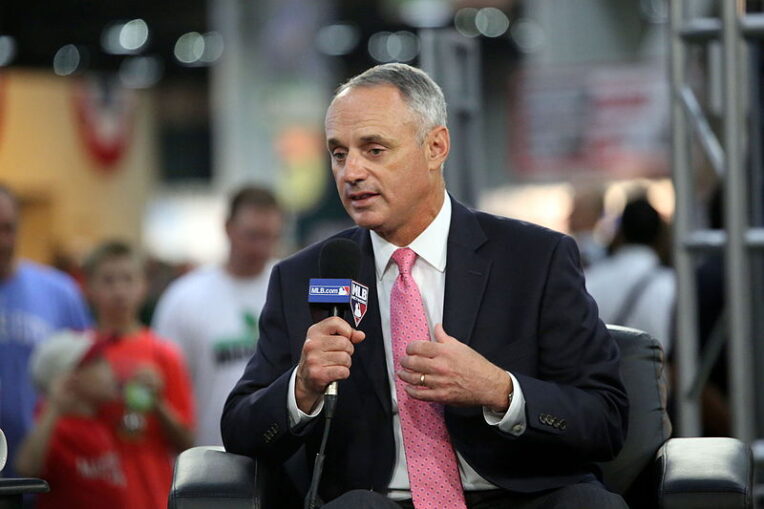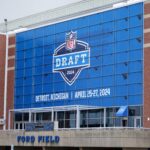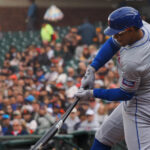
When the New York Mets complete their game against the Los Angeles Dodgers on June 3, the Mets will have played exactly one-third of their 162-game schedule. We know that the team from Flushing is off to a rollicking start, despite injuries to starters Max Scherzer, Jacob deGrom, and Tylor Megill. In an article in The Athletic, Jayson Stark points out some of the key trends in baseball this year. Let’s take a look at some of what has been going on so far this season across Major League Baseball.
Lingering Effects of the Lockout
Just when we thought it was safe to no longer think about the ugly lockout that lasted 99 days, there are some examples of how it has impacted the 2022 season thus far. First, pitchers are not throwing as hard as they did last year. For instance, Shane Bieber is averaging 91.4 mph on his fastball this season, versus 93 mph last year. Former Met Zack Wheeler‘s velocity is down two mph this season as well. Is the lockout responsible? Here’s an American League executive from the cited article:
“You watch this stuff,” this exec said, “and there’s this fear or panic, like what’s going on? I think it’s clear now we’ve seen unusual velocity patterns, because different guys handled the lockout time differently and the spring training time differently. So it’s been really hard to know what to make of players early.”
Another concern of the shortened spring training was the possibility of increased player injuries. So far, that concern has manifested in terms of impact of injuries on playing time. Through 47 days of the season, 286 players have landed on the injured list in 2022, as opposed to 349 players over the same time period a year ago. The time on the injured list has been longer in 2022, averaging 27.6 days in this season versus 23.1 days in 2021.
Home Runs are Down, Strikeouts are Up
If you watch baseball, neither of the above facts will come as a surprise. We have heard and written here on MMO that ball in in fact different this year. Also, while the game seems to be once again valuing the idea of putting the ball in play (permissible shifting will be modified next season), hitters are still striking out in droves.
Stark uses the example of opposite field home runs to illustrate just how significantly the home run has been muted in 2022. In 2019 and 2021, there were 715 and 547 opposite field home runs respectively. This year, the projection at the current pace is for a total of 390 “oppo” home runs.
Looking at strikeouts, the table below (data from Baseball Reference) shows that the “K Problem” rages on.
Season K/HR Runs per Game
|
2022
|
8.47
|
4.22
|
|
2021
|
7.09
|
4.53
|
|
2020
|
6.76
|
4.65
|
|
2019
|
6.32
|
4.83
|
It’s clear that Major League Baseball wants more balls in play, resulting in more game action. Limiting the shift can help, but it won’t do much if batters don’t increase the frequency with which they make contact. From the cited article, there is no easy answer to question of what can be done to put more balls in play:
“At this pace, we’re going to see approximately 36,000 more strikeouts than homers this season — the largest difference ever. And “is that good for our game?” one exec wondered. “I don’t think so.”
“But here’s the question no one can answer,” another exec said. “If we want less home runs, we know how we can do that. But if we want less strikeouts, what’s the answer to that?”
The Pitch Clock is Coming. Does it Work?
The games are long. To some, that’s not a problem, after all, the beauty of baseball is that it doesn’t have a clock. To others, game length is one reason for the game’s declining popularity. On May 30, the Mets game was 3:29, on May 31 the time of game was 3:31, and on June 1, the game lasted 3:02.
The pitch clock is being used in the minor leagues this year. As a reminder, the hurler will have 14 seconds to throw a pitch if there are no runners on base, and 19 seconds if there are no runners on base. Here is the impact it is having in the minor leagues this season.
Games times are down 28 minutes. Strikeouts are down two percent, and walks are down one percent. This, of course, means more balls in play, the desired outcome by MLB. One note, while the pitch clock will be in the major leagues next year, the 14 and 19 second limits are not cast in stone. The Major League Baseball Players’ Association can negotiate different times if they so choose. Some version of a time limit to throw a pitch to the plate will be in place. The average length of a game will likely decrease. Whether or not that has an impact on fan interest is yet to be determined.
If you’re a Mets fan, the 2022 season is off to a great start. However, MLB has identified certain trends that they would like to turn around. The game was essentially static (rule-wise) for almost 50 years, since the Designated Hitter came to the American League. Recently, we have seen ghost runners and seven-inning doubleheaders necessitated by a pandemic.
Baseball seems to have hit an evolutionary phase, with several changes coming (don’t forget the new schedule format in 2023). That’s understandable. Evolution can be essential to survival. Whether the game will evolve correctly and achieve its desired endpoints of expanding interest and its fan base, that part remains to be seen.















